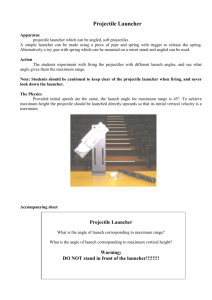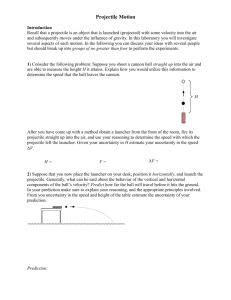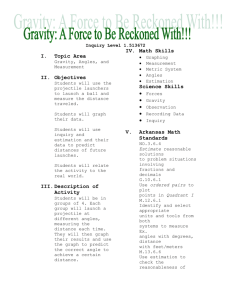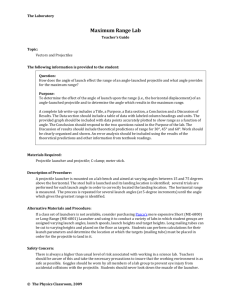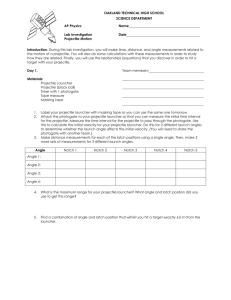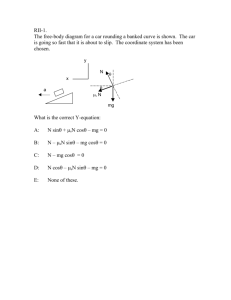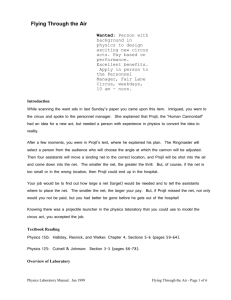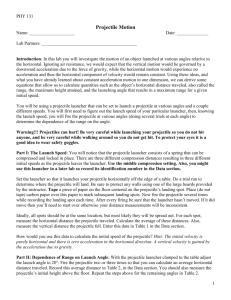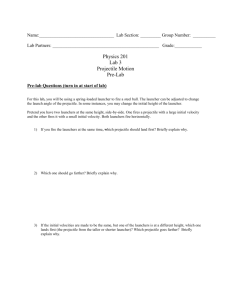LAB 2: Projectiles - University of San Diego Home Pages
advertisement
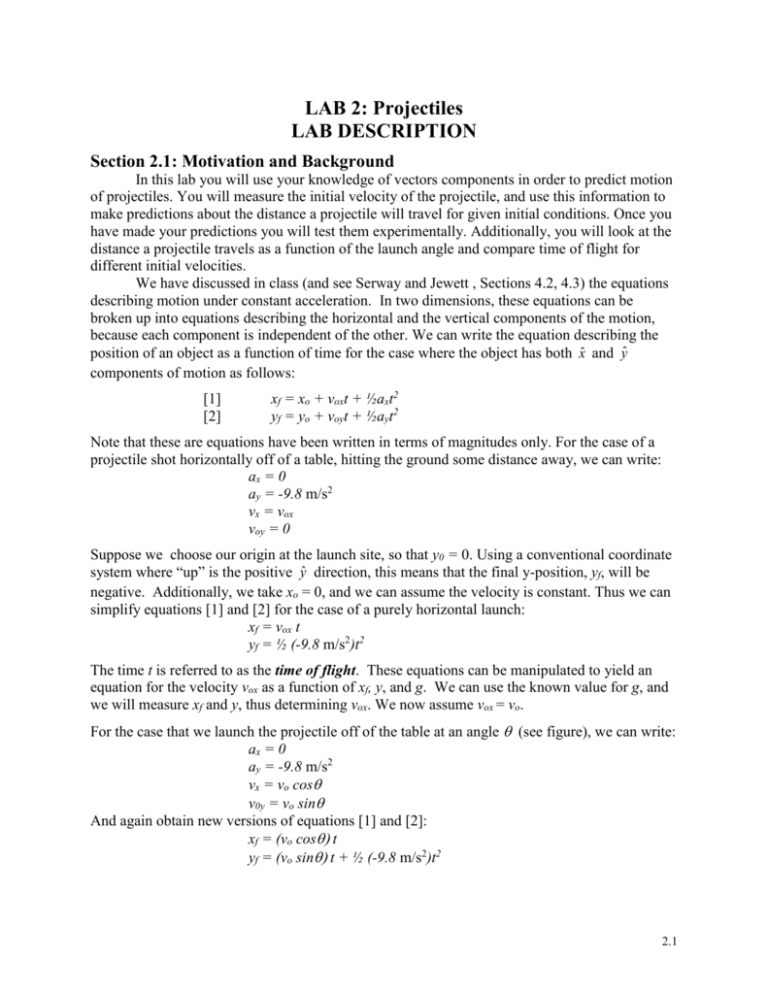
LAB 2: Projectiles LAB DESCRIPTION Section 2.1: Motivation and Background In this lab you will use your knowledge of vectors components in order to predict motion of projectiles. You will measure the initial velocity of the projectile, and use this information to make predictions about the distance a projectile will travel for given initial conditions. Once you have made your predictions you will test them experimentally. Additionally, you will look at the distance a projectile travels as a function of the launch angle and compare time of flight for different initial velocities. We have discussed in class (and see Serway and Jewett , Sections 4.2, 4.3) the equations describing motion under constant acceleration. In two dimensions, these equations can be broken up into equations describing the horizontal and the vertical components of the motion, because each component is independent of the other. We can write the equation describing the position of an object as a function of time for the case where the object has both x̂ and ŷ components of motion as follows: [1] [2] xf = xo + voxt + ½axt2 yf = yo + voyt + ½ayt2 Note that these are equations have been written in terms of magnitudes only. For the case of a projectile shot horizontally off of a table, hitting the ground some distance away, we can write: ax = 0 ay = -9.8 m/s2 vx = vox voy = 0 Suppose we choose our origin at the launch site, so that y0 = 0. Using a conventional coordinate system where “up” is the positive ŷ direction, this means that the final y-position, yf, will be negative. Additionally, we take xo = 0, and we can assume the velocity is constant. Thus we can simplify equations [1] and [2] for the case of a purely horizontal launch: xf = vox t yf = ½ (-9.8 m/s2)t2 The time t is referred to as the time of flight. These equations can be manipulated to yield an equation for the velocity vox as a function of xf, y, and g. We can use the known value for g, and we will measure xf and y, thus determining vox. We now assume vox = vo. For the case that we launch the projectile off of the table at an angle (see figure), we can write: ax = 0 ay = -9.8 m/s2 vx = vo cos v0y = vo sin And again obtain new versions of equations [1] and [2]: xf = (vo cos t yf = (vo sin t + ½ (-9.8 m/s2)t2 2.1 vo y x yi = 0 yf x=0 x = xf Section 2.2: Experimental Set-Up The experimental set-up is fairly straightforward. There is a projectile launcher that shoots a ball out with some initial velocity, vo, which is independent of the angle of launch. The angle of launch can be changed, and there are three possible initial speeds. The projectile launcher comes with the following statements on expectations, quoted from the “PASCO Projectile Launcher Instruction Manual and Experiment Guide.” Take these into consideration when discussing data and determining significant figures. - The muzzle speed will vary slightly with angle. The difference between muzzle speed when shot horizontally versus vertically can be anywhere from zero to 8%, depending on the range setting and the particular launcher. - The scatter pattern is minimized when the Projectile Launcher base is securely clamped to a sturdy table. Any wobble in the table will show up in the data. - The angle of inclination can be determined to within one-half of a degree. You will use carbon paper to mark the location where the ball hits the ground, therefore giving you a measurement of xf. This, combined with the measurement of the height of the Launcher, will give you a value for the initial velocity. The Launcher and the carbon paper are the central components of this experiment. Please always wear your safety goggles. Section 2.3: Procedure (Much of the following is taken directly from the “PASCO Projectile Launcher Instruction Manual and Experiment Guide.”) Part A: Determining vo - Adjust Launcher for a horizontal launch. Put plastic ball into Launcher and cock it to the long range position. Fire one shot to locate where the ball hits the floor. At this position, tape a piece of white paper to the floor. Place a piece of carbon paper, carbon-side down, on top of this paper and tape it down. When the ball hits the floor, it will leave a mark on the white paper. - Fire at least 10 shots. 2.2 - Measure the vertical distance from the bottom of the ball as it leaves the barrel (this position is marked on the side of the barrel) to the floor. - Find the point on the floor that is directly beneath the release point on the barrel. Measure the horizontal distance from this point to each of the dots. (Hint to save time: Measure to the start of the paper, and then measure from the paper’s start to each dot.) - Make a table of your data. Find the average of the five distances and use this, along with the measured vertical distance, to calculate the initial velocity of the ball for the long range position. PART B: Predicting xf - Adjust the angle of the Launcher to an angle of your choice between 30 and 60 degrees. Using the information found in part A, calculate the expected horizontal distance for the angle you have chosen and for the long range setting. Draw a line across the middle of a white piece of paper and tape the paper on the floor so the line is at the predicted horizontal distance from the Launcher. Cover the paper with carbon paper. - Fire at least 10 shots and measure the distances. Make a table of your data. Find the average distance, and calculate the percent difference between this value and the expected value. QUESTIONS 1. Look at the spread of your distances measured in Part B. Estimate an uncertainty implied by this spread of values, and compare this to your % difference calculated in part B. Estimate other possible uncertainties in your measurements. . 2. If the launch in Part B had been done on a level surface, so that the ball landed at the same vertical height from which it started, this would have created a symmetric trajectory. If this were the case, find the angle for which xf is a maximum using calculus. (From calculus, one can find the maximum of some function f(x) by differentiating it with respect to x and setting the result equal to zero). Differentiate equation (4.14) in Serway & Jewett with respect to θ, to find the maximum horizontal range for a symmetric trajectory. We do not have a symmetric trajectory because we launched from the top of a table. Because of this, the angle corresponding to the largest xf (range) will differ from 45 degrees. For a launch off a table, would the angle corresponding to maximum range be larger or smaller than 45 degrees? Support your answer. - Another way of thinking about the preceding question is to think about the scenario where a yprojectile is shot off of a REALLY tall building of height h (so tall that 2gh >> vi2.) In this case, show whether the launch angle that will cause the projectile to land the farthest from the base of the building is larger or smaller than 45 degrees. You could use calculus to do this, as you did above for the case of a symmetric trajectory. 3. Does the time of flight for horizontal launches depend on the initial velocity? Use the given equations to support your answer, and explain in words why this makes sense. 2.3 - For a tilted launch, do you expect the time of flight to depend on the initial velocity? Ref: Much of the above was edited or taken from M. Chabot, Lab 2, Physics 42, Fall 2003. 2.4
